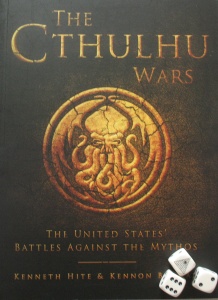Kenneth Hite & Kennon Bauman, Osprey Publishing, 2016

The Cthulhu Wars ‒ The United States’ Battles Against the Mythos is an awesome book by H.P. Lovecraft grognard Kenneth Hite, author of relevant works like GURPS Horror (2011), GURPS WWII: Weird War II (2003), and Trail of Cthulhu (2007), and his co-author Kennon Bauman. This is not a game supplement, however, but an alternate history book in Osprey’s Dark History series. Following Hite’s earlier effort in that line, The Nazi Occult (2013), the book is written as if its subject matter were real and both authors were actual Mythos investigators; in a clear Lovecraft spoof, Hite is even presumed dead after a fire gutted his library …
Osprey mainly publishes lavishly illustrated military history books, and The Cthulhu Wars is produced in the same style as its many more prosaic titles. It is available as a PDF or as an 80-page, full-colour softcover octavo, sold for $18.95/£11.99.
It covers the involvement of US forces ‒ both Federal and military ‒ that were and are battling the varied manifestations of the Mythos. This idea is nothing but brilliant. It recognizes what many Lovecraftian “purists” do not want to acknowledge, which is that the struggle against the Mythos ultimately requires concerted action which by default includes armed aggression. Of course this does not say anything about a successful war against the Mythos.
The book starts in the 16th century and the Colonial Times get pretty substantial treatment, which correlates with the attention given to the period by Lovecraft himself. The CROATOAN mystery is mentioned but remains unexplained. The report on the ousting of the infamous Joseph Curwen by the Providence militia in 1770 includes the first actual battle. The Lewis & Clark Expedition (1804-1806) receives a lot of attention, tying it to various Mythos phenomena.
Curiously, the Civil War (1862-1865) that completely overshadowed American politics, economics, and in many cases personal lives for the rest of the 19th century receives scant mention. Neither does World War I (1914-1918), the dominating event of Lovecraft’s generation. Apparently these did not offer enough Mythos connection.
Like in other, similar treatments, the defining moment of the struggle against the Mythos is the Innsmouth Raid (1928), better known as Operation COVENANT in other sources but called Operation ASHDOD here. This was the first time that the US government clearly identified its supernatural enemies and acted decisively against them. Consequently, the raid and its aftermath are covered in considerable breadth. The authors present a different take on the operation than previous researchers, claiming that the fledgling Bureau of Investigation was the lead agency, rather than agents of the, at the time, much more powerful Treasury Department. The US Navy submarine mentioned by Lovecraft, commonly assumed to have been S 19, is identified here as O 9. The eventual fate of that boat is smoothly explained by the vindictive nature of the Deep Ones.
World War II (1939-1945) is dealt with next, if surprisingly briefly considering the many possible Mythos connections, as evidenced by the extensive coverage in Achtung! Cthulhu, Delta Green, and World War Cthulhu: The Darkest Hour. Perhaps the authors felt that the mentioned game books as well as The Nazi Occult had already exhausted the topic.
Almost half the book describes more recent events set during the cleverly renamed Coldest War (1946-1991) and Global War on Horror (1991-). The scramble for the Arctic and Antarctic is covered in considerable detail. Many early CIA operations are mentioned, most of them largely forgotten today, including in Tibet, the Congo, Southeast Asia, and Nicaragua. The more recent engagements in the Middle East, especially Iraq and Afghanistan, receive considerable attention. Tastefully, they are not compounded with the various religious and ethnic conflicts in that area, but given their own, independent narrative.
A number of other sources have produced material in a similar vein, mainly in the mentioned roleplaying games. The Cthulhu Wars tries to provide a coherent and fairly complete picture, but the authors concentrate on key events and a number of periods receive very little attention. The book shines whenever it pulls together real-life persons, places, and events and then interprets them in light of the Mythos, often by adding only one supernatural ingredient or twist. This clearly follows Lovecraft’s advice in his “Notes on Writing Weird Fiction” (1933). Overall The Cthulhu Wars is brilliantly written. Hite’s unique writing style is engaging and at the same time suitably quirky. Even the amateur student of Lovecraft will immediately recognize both dark and witty allusions and similarities.
Boxes throughout the book explain the main “Necronomicon Related Entities” (NREs). These are well-written but do not offer much that is new to readers of Call of Cthulhu or indeed any Lovecraftian game with a bestiary.
Where the book is somewhat lacking is in the military details. There is only limited talk of strategies, less of tactics, and very little of the details so important to the boots on the ground. This is curious for a military history book in general and for an Osprey book in particular. What is a “sufficient caliber” to kill a Ghoul? How can even a hail of low-powered .45 ACP bullets be enough to bring down a Deep One, when most sources, including this, extol their ruggedness? How does the salvaged and repurposed technology of the Elder Things now used against Shoggoth threats work or even look?
Sadly, this book is as uncertain of its foreign language terms as most Osprey books. For some unexplained reason the authors insist on spelling the Mi-Go “Mi-Gö,” presumably in reference to the pronunciation of the Tibetan word on which it is based. However, in that case it would have to be spelled “Me-Gö.” This affectation is rather annoying, Lovecraft’s work being totally unambiguous about the spelling. Similarly, the German Reichssicherheitshauptamt is spelled like this, not “Reichssicherhauptamt.” Unlike the Mi-Go, Düsseldorf does need its umlaut.
Most of the photos and other illustrations scattered throughout the book are excellent. A number of these have been subtly tampered with ‒ some bulging fish eyes here, a tentacle there. The attentive reader will note a kraken in the background of a seemingly ordinary portrait or bones tucked into the belt of a Civil War soldier. However, some photos, especially many of the more modern ones, do not show anything interesting, either Mythos-related or otherwise, and seem to be mere fillers.
Like all Osprey books, The Cthulhu Wars features full-page painted colour pieces depicting notable events; seven in total, all by artist Darren Tan. Most of these are great. The Deep Ones look suitably menacing, although their preference for ragged loincloths is baffling, especially considering the subtle sexual intimations in Lovecraft’s work and the pretty damn specific references in the Delta Green canon or Alan Moore’s Neonomicon (2011). The Mi-Go ‒ I stick to Lovecraft’s spelling, sorry ‒ are eerily beautiful. The Shoggoths battling a submarine are just awesome. Great Cthulhu himself coming under nuclear attack is well executed, but perhaps too pulpy ‒ frankly it reminds me too much of Godzilla flicks to be terrifying, but that may be more of a comment on Cthulhu in general than this painting specifically.
Most Osprey books put special emphasis on matériel in the colour plates, including arms and uniforms. The illustration of the Special Forces in Afghanistan in 2007 is superb, not only for its depiction of the Mi-Go but also of the tracers poured into the NREs by various airborne guns. The Special Forces shooter in the foreground not only has an accurately-rendered H&K HK416D10RS assault carbine (Investigator Weapons 2: Modern Day, pp. 109-110) with EOTech553 holographic weapon sight (Investigator Weapons 2, p. 196), but also the famous “green eyes” from the back glow of his Litton AN/AVS-9 GEN3 night-vision goggles (Investigator Weapons 2, p. 197).
However, in the illustration of the Innsmouth Raid in 1928, the M1917 helmets and M1923 load-bearing equipment of the Marines are rather off. The one visible Tommy Gun is an amalgamation of mistakes, which is annoying considering how much importance is attached to it both in this book and elsewhere. It lacks the Cutts compensator that was fitted on Auto-Ordnance Model 1921AC and M1928 Thompson guns (Investigator Weapons 1: The 1920s and 1930s, pp. 87-89) used by the USMC at the time, features the non-detachable stock of the M1/M1A1 introduced in 1942, and has the anachronistic 30-round magazine also first introduced in 1942; the latter mistake, at least, is perhaps explained by its inclusion in almost all the secondary sources, including Call of Cthulhu, Sixth Edition (p. 65), Call of Cthulhu, Seventh Edition (p. 404), and Escape from Innsmouth (p. 149).
The MACV-SOG Recon Team in Cambodia in 1968 is improbably armed, with a Springfield M14 rifle and Browning M2HB heavy machine gun. The latter is especially unlikely, as the RTs were inserted by chopper or parachute and had to walk most of the time, which necessitated man-portable weapons that were often further lightened by unit armourers. The Special Forces staff sergeant is armed with a Colt M16A1 assault rifle, which is not impossible but unlikely considering that the teams universally favoured the Colt XM177E2 assault carbine and other CAR-15 versions. I am hoping that The Fall of Delta Green, the eagerly awaited book by Hite on DELTA GREEN operations during the Vietnam War, pays more attention to such details.
Where almost the entire book maintains its conceit that it is a report of real events, the biblio- and filmography in the back weirdly breaks the suspension of disbelief by listing various novels, roleplaying games, and movies. Although the clear credit for the authors’ inspiration is commendable, it does mar the overall picture somewhat.
Gamemasters and Keepers looking to run a Lovecraftian campaign will find a lot of goodness in this book. And that does not only include the obvious inspirations for Achtung! Cthulhu, Delta Green, Delta Green: The Role-Playing Game, The Laundry, World War Cthulhu: The Darkest Hour, or World War Cthulhu: Cold War. A Keeper will also find plenty of inspiration if he is running a scenario set during Colonial Times or even Chaosium’s Escape from Innsmouth or Beyond the Mountains of Madness. Similarly, gamemasters planning a campaign using GURPS Horror in combination with GURPS Atlantis, GURPS SEALs in Vietnam, and/or GURPS Special Ops will likewise find The Cthulhu Wars extremely helpful.
As has already been mentioned, The Cthulhu Wars is not directly compatible with other forays into the same topic. You will find no mentioning of DELTA GREEN, MAJESTIC-12, etc. The authors chose to use different names, organizations, units, and so on, presumably for copyright reasons. That is understandable and while some readers might find it confusing, it is not a problem to weave the material into a preferred campaign background. And really, this is entirely in the spirit of Lovecraft himself, who unintentionally or deliberately left much of his information on the Mythos vague and chaotic.
All in all, The Cthulhu Wars is way too short. No mentioning of the long and savage Indian Wars? Not a word on the invasion of Hawaii (1893) or the Battle of Tagalii (1899) on Samoa, or the much longer engagements on the Philippines and in China? A mere paragraph on WWI? Not even three pages covering WWII? The Vietnam War gets a half-page? I want more!
